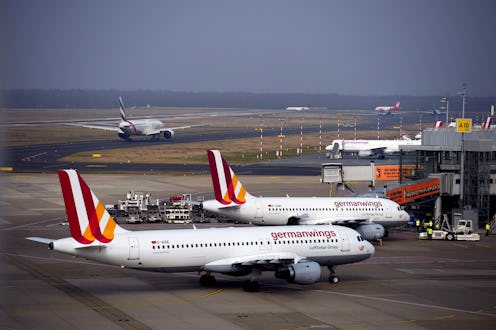News
4 Theories To Help Explain The Germanwings Crash
Whatever the actual numbers say about the safety of air travel (and, yes, they still say it's far safer than driving), the world's nervous flyers have had a rather harrowing last year or so. Whether you're talking about either of the Malaysian Airlines flights that went down last year, the AirAsia disaster, TransAsia Airways, you name it — these sorts of frightening stories tend to stick in your mind. Now, yet another plane has gone down: here are four theories to explain the Germanwings plane crash, at least as best we can at this early hour.
Make no mistake — the true, fully fleshed-out cause of this awful wreck may take a while to sort out. If anything's been laid bare by the past year and a half of aerial catastrophe, it's that these stories don't always end with a tidy little package of information. The MH370 crash, for example — we still really have no credible idea what happened to cause that airliner to vanish like it did.
For what it's worth, what information is already available on Germanwings Flight 4U9525 seems to suggest a much less mysterious situation than Malaysia Airlines Flight 370 was. Regardless, it's important to remember that these are nothing but theories in the early stages of a news story.
Flight 4U9525 Abruptly Lost Altitude, Just Like A Recent Sister Plane
As detailed by the Daily Mail, while the Airbus A320 is a widely used model of plane, and considered very safe by and large, the folks at Germanwings should have gotten a warning about it recently. Basically, four months ago an identical make of plane (operated by German airline Lufthansa, which wholly owns Germanwings) abruptly began losing altitude, reportedly dropping 3,000 feet in under a minute before the pilots regained control and stabilized the plane.
The problem was blamed on a faulty sensor, and the European Air Safety Agency issued a safety warning stating for four different types of Airbus planes, the A320 included.
Flight 4U9525 Suffered Catastrophic Failure
As detailed by The Daily Beast's Clive Irving, Flight 4U9525 was ascending, and reached about a 30,000 foot altitude when something went wrong. According to Germanwings' CEO, the plane's passage over the Alps was marred by an eight-minute period of descent, followed by a complete drop-off from any available radar monitoring.
Irving, also a senior consulting editor for Condé Nast Traveler with a speciality in aviation, claims that this sequence of events suggests either a massive structural or engine failure.
Flight 4U9525 Suffered A Similar Fate As AirAsia Flight 8501
It's understandable that people would be examining any incidents with any other Airbus A320s with a fine-tooth comb right now, and beyond even that near-miss moment with the Lufthansa flight, you needn't look far to find a similar, fatal wreck. That's because AirAsia Flight 8505 was also an Airbus A320, although that doesn't give as much useful information as it might — we still don't know exactly why that plane crashed (some Indonesian experts suggested "icing" may have been to blame, but the full picture isn't clear), so that information is of limited utility right now.
In fact, given that FU49525 crashed over land rather than sea, it's entirely likely we'll get a clearer answer to what happened here than we did AirAsia. Maybe the eventual analysis of what happened here could actually help shed some light on that past tragedy.
The Pilots Sent No SOS Signal
This has been the subject of conflicting reports, and it's pretty important for obvious reasons. If the pilot of FU49525 indeed sent out a distress signal, that at least rules out a complete communications blackout. And in the early aftermath of the crash, reports were flying that this had indeed happened.
But now, the reporting has changed — according to The Independent, no such call went out from the plane itself. Rather, according to French aviation officials, the reports referred to a warning signal given by air traffic control after the plane vanished from radar.
Images: Getty Images (4)
